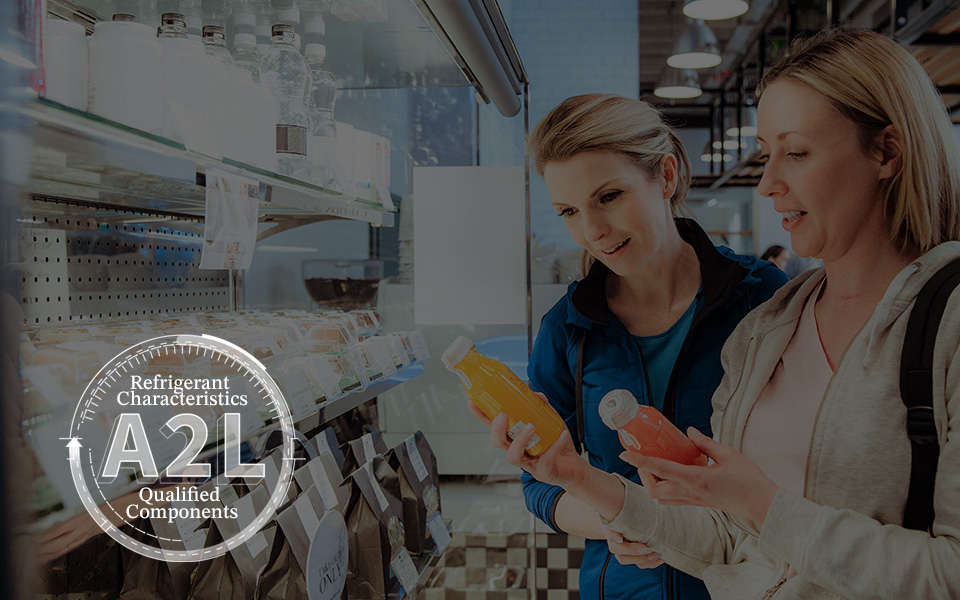*On June 1, 2023 Emerson’s Climate Technologies business became a new standalone company – Copeland. Though our name has changed, we are building on more than a century of HVACR innovation and industry leadership, and Copeland continues to offer the same products, industry stewardship, and learning opportunities you’ve grown to trust. Information found on this webpage posted before June 1, 2023 may contain our old name or branding, but you can be at ease knowing it was created with the knowledge and expertise of Copeland.
As we’ve discussed previously in this A2L Fundamentals video and blog series, the stage is set for lower-global warming potential (GWP) A2L refrigerants to play an expanded role in commercial refrigeration. Compared to legacy A1 hydrofluorocarbon (HFC) refrigerants, mildly flammable A2L refrigerants have similar performance characteristics. As an alternative to propane (R-290), A2Ls have much larger charge limits creating opportunity in mid to large systems. For the final blog in this series, I’ll look at some of the A2L key performance characteristics that may impact refrigerant choice and design considerations.

The primary reason for transitioning to an A2L refrigerant is to lower the GWP footprint in your refrigeration applications. A2Ls are composed of various blends and single-source components — such as hydrofluoroolefins (HFOs) and HFCs — that are designed to meet emerging regulatory thresholds below 150 and 300 GWP. Achieving these lower-GWP levels essentially eliminate traditional A1 refrigerants to achieve similar performance, but there are various options within the A2L “lower-flammability” classification that can achieve these results, but there are trade offs to consider. Each specific A2L refrigerant will have different GWP, flammability ratings, and variations in performance characteristics.
For example, Copeland has chosen these lower-GWP options for the A2L-qualification process in our Copeland™ refrigeration scroll, semi-hermetic, hermetic reciprocating compressors as well as our condensing units and electronics:
- R-454C (148 GWP)
- R-455A (146 GWP)
- R-454A (238 GWP)
Each refrigerant offers unique thermodynamic properties and performance characteristics that are similar, and in some cases better, than today’s A1 HFC refrigerants such as R-404A or R-448A. We are currently in the process of qualifying our compressor and condensing unit lineups with these A2Ls across the board.
A2L refrigerant glide considerations
Refrigerants are often comprised of a blend of two or more constituents. These individual components’ different saturation temperatures can impact the refrigerant’s performance characteristics. Working with refrigerants with glide requires understanding the boiling point of each of its constituents:
- Bubble point, or lowest condensing temperature of a constituent
- Mean condensing temperature
- Dew point, or the highest condensing temperature of a constituent
The difference between the boiling points of the first and last constituents is referred to as glide. Essentially, the least volatile component condenses first, and each additional component of a refrigerant blend will start and end at different boiling points. The total temperature glide of a refrigerant blend is defined as the temperature difference between the saturated vapor temperature and the saturated liquid temperature at a constant pressure. An alternate definition is the temperature difference between the starting and ending temperatures of a refrigerant phase change within a system at a constant pressure.
For example, at a medium-temperature condition, R-455A has roughly a 22 °F glide, but also has a higher compressor capacity than R-404A. Other A2Ls, such as R-454C, may have less glide but offer lower compressor capacity, similar to R-448A. As is the case with any refrigerant, glide is a key consideration when designing a refrigeration system
Higher refrigerant charges equal higher capacities
To prepare for the approaching adoption of A2Ls, Copeland and its original equipment manufacturer (OEM) partners are developing A2L-qualified equipment that maximize their advantages. Compared to R-290, the increased A2L charge limits enable higher refrigeration capacities in self-contained units — and new possibilities for remote equipment. A2L-qualified Copeland variable-speed compressor technologies are specifically designed to increase the cooling capacity and efficiency in these applications with less charge.
Variable-speed compressors are designed to run at up to twice the speed of a typical fixed-speed compressor. This increased speed doubles the refrigerant mass flow providing two times the compressor cooling capacity — all while using smaller charges of lower-GWP A2L refrigerants. In essence, one variable-speed compressor can deliver the same capacity as two fixed-speed models, eliminating the need for multiple refrigeration circuits in some instances.
In addition, Copeland A2L-qualified, variable-speed compressors deliver multiple operational and efficiency improvements, including:
- Energy efficiency gains that are typically 20–30 percent
- Variable-capacity modulation from 20–200 percent
- Precise load matching and improved temperature control
Greatly reduced, and controllable sound levels
Copeland compressors, electronic controls and components are currently undergoing the A2L-qualifcation process to ensure safety, reliability and performance in future equipment applications. In addition, we’re helping our OEM partners to integrate these components and complete their design cycles for A2L certification.
To learn more about A2L refrigerant characteristics, safety and servicing best practices, and the regulatory path for approval, please view the A2L Fundamentals video series. Visit our A2L resource center to learn more about how Copeland is helping the commercial refrigeration industry prepare for the emergence of A2L refrigerants.

8 proven strategies for rigorous cold chain management
Preparing for the approval and safe use of A2Ls in commercial refrigeration applications...
Protection for high-value shipments just got even better
We’re excited to announce the release of Copeland’s newest real-time tracker, the GO Real-Time...

Three proven strategies to prevent cargo theft
The over-the-road (OTR) transport industry is experiencing a surge in cargo thefts. As thieves...
